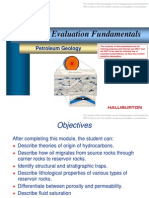Reservoir
Reservoir
Uploaded by
Miko Paulo TiotangcoCopyright:
Available Formats
Reservoir
Reservoir
Uploaded by
Miko Paulo TiotangcoOriginal Description:
Copyright
Available Formats
Share this document
Did you find this document useful?
Is this content inappropriate?
Copyright:
Available Formats
Reservoir
Reservoir
Uploaded by
Miko Paulo TiotangcoCopyright:
Available Formats
Petroleum Geology
The
Reservoi
r
Reservoir Geology
A petroleum reservoir is a subsurface formation containing gas, oil, and
water in varying proportions. These fluids are contained in the pore spaces of
rock formations, among the grains of sandstones or in cavities of carbonates.
The pore spaces are interconnected so the fluids can move through the
reservoir.
These porous formations have to be sealed in such a way so that the only
method of escape for the fluids is through the wellbore.
Theoretically, any rock may act as a reservoir for oil and gas. In practice, the
sandstones and carbonates contain the major reserves, although fields do
occur in shales and diverse igneous and metamorphic rocks. For a rock to act
as a reservoir it must possess two essential properties: it must have pores to
contain the oil or gas, and there must be good permeability. Remember that
porous rock is not necessary permeable. To be permeable, rock must have
pores that interconnect, allowing fluids to flow from one pore to another.
Physical Characteristics of a Reservoir
Physical characteristics of a reservoir include:
1. type of reservoir (sandstone or carbonate)
2. depth
3. area and thickness
4. porosity
5. permeability and,
6. capillary pressure
1.Type of Reservoir
Depth
Petroleum Geology
Most Common Types of Reservoir Rocks
1. Sandstone 60%
2. Carbonates 39%
These lithologies host almost all of the worlds oil reserves.
The
Reservoi
r
Petroleum Geology
The
Reservoi
r
Petroleum Geology
The
Reservoi
r
2.Depth
The physical characteristics of a reservoir are greatly affected by the depth
at which they occur.
Shallow reservoir Created by the folding of relatively thick, moderately
compacted reservoir rock with accumulation under an anticline or some trap.
The hydrocarbons would generally be better separated as a result of lower
internal reservoir pressures, less gas in solution and oil of increased
viscosity, resulting from lower temperatures.
Deep reservoir Typically created by severe faulting. The hydrocarbons
would be less separated with more gas in solution and oil of reduced
viscosity because of higher temperatures. There is often a reduction in
porosity and permeability due to increased compaction
3.Area and Thickness
The total area of a reservoir and its thickness are of considerable importance
in determining if a reservoir is a commercial one or not. The greater the area
and thickness of the reservoir, the greater the potential for large
accumulations of oil and gas. However, there are reservoirs that produce
substantial amounts of hydrocarbons that are not of considerable size.
Petroleum Geology
The
Reservoi
r
4.Porosity
Pore spaces, or voids, within a rock are generally filled with connate water, but
contain oil or gas within a reservoir. Porosity is either expressed as the void ratio,
which is the ratio of voids to solid rock, or, more frequently, as a percentage:
Porosity ( ) =
volume of voids
100
total volume of rock
Porous sandstone
Porosity is conventionally given the symbol for phi (). Pores are of three types;
catenary, cul-de-sac, and closed.
Catenary pores are those that have open links to other pores. Cul-de-sac, or dead
end, pores have only one passage connecting with another pore. Closed pores have
no openings to other pores.
Catenary and cul-de-sac pores constitute effective porosity, in that hydrocarbons
can emerge from them. In catenary pores hydrocarbons can be flushed out by a
natural or artificial water drive. Cul-de-sac pores are unaffected by flushing, but
may yield some oil or gas by expansion as reservoir pressure drops. Closed pores
are unable to yield hydrocarbons, such as hydrocarbon having invaded an open
pore that closed by compaction or cementation. The ratio of total to effective
porosity is extremely important, being directly related to the permeability of a rock.
Primary Porosity
5
Petroleum Geology
The
Reservoi
r
Primary porosity may be divided into two types: interparticle and intraparticle.
Interparticle porosity is initially present in all sediments. They are often quickly lost
in clays and carbonate sands due to the effects of compaction and cementation.
Much of the porosity found in sandstone reservoirs is preserved primary
interparticle porosity. Intraparticle pores are generally found within the skeletal
grains of carbonate sands and are often cul-de-sac pores.
Secondary Porosity
Secondary pores are often caused by solution. Many minerals may be leached out of
a rock, but carbonate solution is the most significant. Thus solution-induced porosity
is more common in carbonate reservoirs than in sandstone reservoirs. Vugs are a
type of secondary porosity where the pores cross cut grains, matrix, and cement.
Vugs tend to be larger than most other types of pores. With increasing size vuggy
porosity changes into cavernous porosity. Cavernous pores are those large enough
to cause the drill string to drop by half a meter. Examples of cavernous porosity are
known from the Arab D Jurassic limestone of the Abqaiq field of Saudi Arabia and
from the Fusselman limestone of the Dollarhide field of Texas, both having
cavernous pores up to 5m high.
Fracture Porosity
Fracture porosity is extremely important not just because it increases the storage
capacity of a reservoir but because of the degree to which it may enhance
permeability. A few microfractures can increase permeability by many orders of
magnitude. Fractures are rare in unconsolidated, loosely cemented sediments,
which respond to stress by plastic flow. They may occur in any brittle rock, not only
sandstones and limestones but also shales and igneous and metamorphic rocks.
The two basic types of fractures include natural tectonically related fractures and
hydraulically induced fractures. Hydraulic fracturing is a method of stimulating
production by inducing fractures and fissures in the formation by injecting fluids into
the reservoir rock at pressures which exceed the strength of the rock. Hydraulic
fracturing can tremendously increase the effective porosity and permeability of a
formation
Petroleum Geology
The
Reservoi
r
Maximum Porosity vs. Realistic Porosity Porosity can approach, in very well
sorted uncompacted sand, a theoretical maximum of 47.6%. In sandstone, this
value is typically much lower due to cementation and compaction. In a carbonate, it
is possible to greatly exceed the theoretical maximum porosity. This may be
achieved if the carbonate is highly fractured along with vuggy porosity.
Controls on Porosity
In sandstone, porosity is largely controlled by sorting. Sorting is a process by
which the agents of transportation, especially running water, naturally separate
sedimentary particles that have some particular characteristic (such as size, shape
or specific gravity) from associated but dissimilar particles. Other important
controlling factors include grain packing, compaction, and cementation.
Petroleum Geology
The
Reservoi
r
Packing strongly affects the bulk density of the rocks as well as their porosity and
permeability. The effects of packing on porosity can be illustrated by considering the
change in porosity that takes place when even-size spheres are rearranged from
open packing (cubic packing) to tightest or closed packing (rhombohedral packing).
8
Petroleum Geology
The
Reservoi
r
Cubic packing can yield a porosity of 47.6%. Rhombohedral packing yields
approximately 26.0%.
Petroleum Geology
The
Reservoi
r
5.Permeability
An essential requirement for a reservoir rock is permeability. Permeability is
ability of fluids to pass through a porous material. The unit of permeability is
Darcy, but because most reservoirs have permeabilities of less than one Darcy,
millidarcy (md) is used. Average permeabilities in reservoirs are commonly in
range of 5 to 500 md. Permeability is generally referred to by the letter K.
the
the
the
the
Absolute permeability: ability to flow or transmit fluids through a rock, conducted
when a single fluid, or phase, is present in the rock.
Effective permeability: The ability to preferentially flow or transmit a particular
fluid when other immiscible fluids are present in the reservoir. If a single fluid is
present in a rock, its relative permeability is 1.0
Relative permeability: is the ratio of effective permeability of a particular fluid at
a particular saturation to absolute permeability of that fluid at total saturation.
Examples of variations in permeability and porosity
Some fine-grained sandstone can have large amounts of interconnected porosity;
however, the individual pores may be quite small. As a result, the pore throats
connecting individual pores may be quite restricted and tortuous; therefore, the
permeabilities of such fine-grained formations may be quite low.
Shales and clays which contain very fine-grained particles often exhibit very
high porosities. However, because the pores and pore throats within these
formations are so small, most shales and clays exhibit virtually no permeability.
10
Petroleum Geology
The
Reservoi
r
Some limestones may contain very little porosity, or isolated vuggy porosity that is
not interconnected. These types of formations will exhibit very little permeability.
However, if the formation is naturally fractured (or even hydraulically fractured),
permeability will be higher because the isolated pores are interconnected by the
fractures.
NOTE:
POROSITY IS NOT DEPENDENT ON GRAIN SIZE
PERMEABILITY IS DEPENDENT ON GRAIN SIZE
6.Capillary Pressure
Reservoir rocks are composed of varying sizes of grains, pores, and capillaries
(channels between grains which connect pores together, sometimes called pore
throats). As the size of the pores and channels decrease, the surface tension of
fluids in the rock increases. When there are several fluids in the rock, each fluid has
a different surface tension and adhesion that causes a pressure variation between
those fluids. This pressure is called capillary pressure and is often sufficient to
prevent the flow of one fluid in the presence of another.
11
Petroleum Geology
The
Reservoi
r
Migration
Migration is the process of the oil and gas moving away from the source rock. This is
a slow process. Migration is caused by burial, compaction, and increase in volume
and separation of the source rock constituents.
There are three types of migration:
Primary migration: is the process of movement from source rock. As sediments
build up to greater thickness in sedimentary basins, fluids are squeezed out by the
weight of the overlying sediments. Fluids tend to move toward the lowest potential
energy. Initially this is upwards, but as compaction progresses; there is lateral as
well as vertical movement. Finally the mechanism that oil migrates is uncertain.
Secondary migration: is movement to or within the reservoir entrapment. Once
the water, oil and gas migrate into the trap, it separates according to density. Gas
being the lightest, goes to the top of the trap to form the free gas cap. Oil goes to
the middle and water that is always present, on the bottom.
Tertiary migration: movement from one reservoir to another (e. g. through faults).
12
Petroleum Geology
The
Reservoi
r
Fluid Distribution within a Reservoir
Petroleum reservoirs generally contain a combination of three fluids:
1). Natural Gas
2). Oil
3). Water
As hydrocarbons and water accumulate in a reservoir, vertical separation occurs as
a result of the difference in the specific gravity of the various fluids. Typically, the
lighter fluids, like gas, rise to the top of the reservoir. Below the lighter fluids is a
gas to oil transition zone. This transition zone is a relatively thin zone above the oil
accumulation.
The oil accumulation may be of primary importance because it contains crude oil
and possibly saturated gas. Below the oil accumulation in most reservoirs is an oilwater transition zone of varying thickness, which is partly filled with water and oil.
Finally, beneath the oil-water transition zone is that part of the formation completely
13
Petroleum Geology
The
Reservoi
r
saturated with water. It is important to note that all reservoirs may not contain
natural gas, oil, and water. Some formations may only contain water. However, any
formation that contains hydrocarbons will also contain some amount of water.
14
You might also like
- Allan, D.S. & Delair, J.B. - When The Earth Nearly Died - Compelling Evidence For A World Cataclysm 11,500 Years AgoDocument369 pagesAllan, D.S. & Delair, J.B. - When The Earth Nearly Died - Compelling Evidence For A World Cataclysm 11,500 Years Agoxdrakulx100% (1)
- Landscape Definition and Description Clutha Mata-Au River May 2007Document72 pagesLandscape Definition and Description Clutha Mata-Au River May 2007Clutha Mata-Au River Parkway GroupNo ratings yet
- Topic 6 - Reservoir RocksDocument12 pagesTopic 6 - Reservoir RockswevansNo ratings yet
- Pet Geo 1Document5 pagesPet Geo 1api-347509160No ratings yet
- Reservoir AssignmentDocument15 pagesReservoir AssignmentAsmadNo ratings yet
- Notes 2 Reservoir Rocks 2010Document14 pagesNotes 2 Reservoir Rocks 2010cssdNo ratings yet
- PorosityDocument11 pagesPorositySaroo BastkyNo ratings yet
- 2 Fundamentals of Quantitative Log Interpretation PDFDocument4 pages2 Fundamentals of Quantitative Log Interpretation PDFlolobsNo ratings yet
- Drilling Lab. 3 Porosity - Permeability Measurment at LabDocument16 pagesDrilling Lab. 3 Porosity - Permeability Measurment at Labali100% (1)
- Fundamentos de Interpretacion de RegistrosDocument9 pagesFundamentos de Interpretacion de RegistrosJoseline TorresNo ratings yet
- Petroleum ReservoirsDocument6 pagesPetroleum ReservoirsNehal patelNo ratings yet
- Lecture - 6 - Reservoirs RocksDocument29 pagesLecture - 6 - Reservoirs RocksMṜ ΛßßΛSNo ratings yet
- 2 Chapter2 ReservoirDocument129 pages2 Chapter2 Reservoirminh.ly2002100% (1)
- Properties of Rservoir RocksDocument22 pagesProperties of Rservoir RocksPaulo IvoNo ratings yet
- Basic Reservoir Concepts1Document31 pagesBasic Reservoir Concepts1malek_prmNo ratings yet
- زينب عبد الرزاق 25Document13 pagesزينب عبد الرزاق 25Narjes WalidNo ratings yet
- 1 Introduction To Reservoir Rock PropertiesDocument20 pages1 Introduction To Reservoir Rock PropertiesAram RafiqNo ratings yet
- E.1. Rock Properties: PorosityDocument40 pagesE.1. Rock Properties: PorosityDedy DayatNo ratings yet
- Lecture Reservoir-PropertiesDocument4 pagesLecture Reservoir-PropertiesDavid Alfonso CaraballoNo ratings yet
- Fundamentals of Quantitative Log InterpretationDocument2 pagesFundamentals of Quantitative Log InterpretationJenniferAriasNo ratings yet
- Lesson 2Document5 pagesLesson 2rya336437No ratings yet
- Fundamental Log InterpretationDocument18 pagesFundamental Log InterpretationRebaz AbdulqadrNo ratings yet
- Expulsion and Migration of Hydrocarbon Assignment Auto Saved)Document9 pagesExpulsion and Migration of Hydrocarbon Assignment Auto Saved)Tuqeer MuhammadNo ratings yet
- Advanced Petroleum Geology - 8Document114 pagesAdvanced Petroleum Geology - 8aliy2k4uNo ratings yet
- Petroleum Geology 2Document15 pagesPetroleum Geology 2Hazael HortonNo ratings yet
- Lesson 1Document4 pagesLesson 1rya336437No ratings yet
- 02 Petroleum GeologyDocument48 pages02 Petroleum GeologygirilingamNo ratings yet
- 4-Chapter4 SealDocument19 pages4-Chapter4 Sealtamngo2206No ratings yet
- Lecture 3 - A PorosityDocument34 pagesLecture 3 - A PorosityRebaz TarmaeNo ratings yet
- 2 - Physical Chatacteristics of The Reservoir (Online)Document24 pages2 - Physical Chatacteristics of The Reservoir (Online)muntasirstoryNo ratings yet
- UNIT I CorrectedDocument37 pagesUNIT I CorrectedHameed Bin AhmadNo ratings yet
- Assign AnsDocument3 pagesAssign Anslovely petsNo ratings yet
- Fundamental Properties of Reservoir RocksDocument55 pagesFundamental Properties of Reservoir Rocksyimam aliNo ratings yet
- Fundamentals of Rock Properties: Akhilome .E. ChristianDocument30 pagesFundamentals of Rock Properties: Akhilome .E. ChristiansereptNo ratings yet
- Oil and Gas: Figure 4 8 - Hydrocarbon MoleculesDocument10 pagesOil and Gas: Figure 4 8 - Hydrocarbon MoleculesweldsvNo ratings yet
- Porosity: Primary Porosity - Amount of Pore Space Present in The Sediment at The Time ofDocument5 pagesPorosity: Primary Porosity - Amount of Pore Space Present in The Sediment at The Time ofeng27alijabbarNo ratings yet
- Section VI - PetrophysicalPPties of ResRocksDocument7 pagesSection VI - PetrophysicalPPties of ResRocksRotimi OwowaNo ratings yet
- Porosity, Permeability & Skin FactorDocument27 pagesPorosity, Permeability & Skin FactorPratick Tibrewala100% (1)
- المكامن النفطية المرحلة الرابعة جيولوجيا النفط كلية العلوم جامعة ديالىDocument33 pagesالمكامن النفطية المرحلة الرابعة جيولوجيا النفط كلية العلوم جامعة ديالىعبدالله خيريNo ratings yet
- Natural Gas Processing TechnologyDocument172 pagesNatural Gas Processing TechnologyariniNo ratings yet
- Stabilizing Sensitive Shales With Inhibited, Potassium-Based Drilling FluidsDocument12 pagesStabilizing Sensitive Shales With Inhibited, Potassium-Based Drilling Fluidstaufiq01No ratings yet
- Lecture 5Document16 pagesLecture 5Yousef AhmadNo ratings yet
- Petroleum System P3Document20 pagesPetroleum System P3Ahmed AyadNo ratings yet
- Petroleum Companies Exam For Geologists Questions and AnswersDocument9 pagesPetroleum Companies Exam For Geologists Questions and Answersrafiullah353No ratings yet
- Petroleum Rock Properties Detailed ReportDocument2 pagesPetroleum Rock Properties Detailed Reportbeshoy naseefNo ratings yet
- Petroleum TrapDocument9 pagesPetroleum TrapAn Open Letter100% (1)
- 23991Document30 pages23991AshrafNo ratings yet
- New Theory and Practice of the Dimensional Oil and Gas Deposits in Fracture ReservoirsFrom EverandNew Theory and Practice of the Dimensional Oil and Gas Deposits in Fracture ReservoirsNo ratings yet
- Scientific American Supplement, No. 508, September 26, 1885From EverandScientific American Supplement, No. 508, September 26, 1885No ratings yet
- Building With Flint: A Practical Guide to the Use of Flint in Design and ArchitectureFrom EverandBuilding With Flint: A Practical Guide to the Use of Flint in Design and ArchitectureNo ratings yet
- Geological Report on Asbestos and its Indications, in the Province of Quebec, CanadaFrom EverandGeological Report on Asbestos and its Indications, in the Province of Quebec, CanadaNo ratings yet
- LS Types & Site Specific Investigations - Saibal - GhoshDocument81 pagesLS Types & Site Specific Investigations - Saibal - GhoshJina MandalNo ratings yet
- Regency Resources LTD: Annual Report For E11/2005 Savage River For The Period 11 May 2007 To 12 May 2008Document30 pagesRegency Resources LTD: Annual Report For E11/2005 Savage River For The Period 11 May 2007 To 12 May 2008Marcel G. CastañedaNo ratings yet
- Cover Letter-Ryan Bobby Andika CGGDocument2 pagesCover Letter-Ryan Bobby Andika CGGronaria situngkirNo ratings yet
- Applications of 1D and 2D Electrical Resistivity MDocument11 pagesApplications of 1D and 2D Electrical Resistivity MFaniyi Hussein KehindeNo ratings yet
- Ring of Fire PDFDocument73 pagesRing of Fire PDFLara Jane LopegaNo ratings yet
- Homework Assignment Well LoggingDocument10 pagesHomework Assignment Well Loggingkpratik41100% (1)
- Petroleum Science and TechnologyDocument12 pagesPetroleum Science and TechnologyRandiRahmansyahNo ratings yet
- Banggai SulaDocument20 pagesBanggai SulaSezyano SiipNo ratings yet
- BW Design ExampleDocument17 pagesBW Design ExampleHaryo ArmonoNo ratings yet
- Basic PetrophysicsDocument27 pagesBasic Petrophysicsaslam_wawa6449No ratings yet
- ES Q2 Mod8Document26 pagesES Q2 Mod8maacovsNo ratings yet
- Complete Download The Sea Floor An Introduction to Marine Geology 4th Edition Eugen Seibold PDF All ChaptersDocument52 pagesComplete Download The Sea Floor An Introduction to Marine Geology 4th Edition Eugen Seibold PDF All Chaptersbooleaniahby100% (4)
- Britmindogroupcompanyprofile PDFDocument20 pagesBritmindogroupcompanyprofile PDFSatia Aji PamungkasNo ratings yet
- Seismic Evalutaionofa Liquid Nitrogen TankDocument47 pagesSeismic Evalutaionofa Liquid Nitrogen TankTharach JanesuapasaereeNo ratings yet
- LESSON PLAN. MondayDocument10 pagesLESSON PLAN. Mondayrezamae89No ratings yet
- Method For Prediction of Micropile Resistance For Slope Stabilization PDFDocument30 pagesMethod For Prediction of Micropile Resistance For Slope Stabilization PDFAnonymous Re62LKaACNo ratings yet
- Class 7 Holiday Homework Session 2022-23Document17 pagesClass 7 Holiday Homework Session 2022-23Bimal Lalani JainNo ratings yet
- Geotech Module 2Document86 pagesGeotech Module 2Christian Valerio100% (1)
- Science 9 Quarter IIIDocument2 pagesScience 9 Quarter IIIArvin Arne Rodrigo67% (3)
- Geology of Rajpura-Dariba Group of Rocks: P. K. YadavDocument14 pagesGeology of Rajpura-Dariba Group of Rocks: P. K. Yadavsiva1192No ratings yet
- Quiz G8 Intensity and MagnitudeDocument1 pageQuiz G8 Intensity and MagnitudeYvonne CuevasNo ratings yet
- Welsh Mine Preservation Trust Newsletter February 2007Document45 pagesWelsh Mine Preservation Trust Newsletter February 2007Welsh Mines Preservation TrustNo ratings yet
- Encyclopaedia of Islam (2nd Ed) - Vol. 04/12 IRAN-KHADocument1,249 pagesEncyclopaedia of Islam (2nd Ed) - Vol. 04/12 IRAN-KHAyskndr50% (2)
- TextDocument2 pagesTextbrightonwumere2003No ratings yet
- Pump Test ReportDocument69 pagesPump Test ReportmitualvesNo ratings yet
- Sedimentary Rocks PDFDocument12 pagesSedimentary Rocks PDFJeremy RambaNo ratings yet
- Unit Six: Fluvial Processes and LandformsDocument123 pagesUnit Six: Fluvial Processes and LandformsAntariksa PrianggaraNo ratings yet
- Effects of VolcanoesDocument39 pagesEffects of VolcanoesAngeline Panaligan AnselaNo ratings yet

























































































